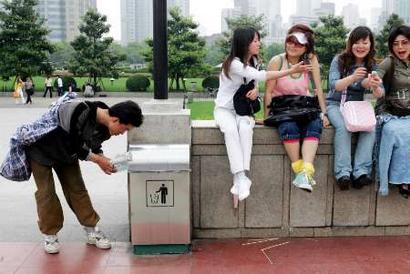Society in a reversed T-shape - expert
(Chinanews)
Updated: 2006-08-08 07:06
At present, China's social structure is like a reversed T-shape, which is an
irrational social structure.

A man collects recyclable garbage
next to girls relaxing in a park in Shanghai, in this picture taken May 9,
2004. The gap between rich and poor in Shanghai is widening rapidly
although the economy of China's financial hub grew 13.5 per cent in the
first quarter of the
year. [Reuters] |
Even if China started
now to implement some strategies to speed up the urbanization and
industrialization process, it might still take China at least 40 years to change
this structure.
The statement was made by Li Qiang, director of the Human Science Department
of the Beijing-based Tsinghua University when he recently gave a lecture to some
young people working in public service institutions.
At the beginning of this year, Li first proposed his idea
of the reversed T-shape social structure in one of his theses.
Based on the statistics in the fifth national population census, Li concluded
that the social structure in China had undergone tremendous changes.
It was not the traditionally pyramid-shaped society, nor was it a spin-shaped
society like some Western countries where the middle-class makes up the greater
part of society.
The fact
that China's society structure is now in a reversed T-shape reflects a serious
fact: in China, the lower strata make up an irrationally large part of society.
Li said the direct reason for the reversed T-shaped social structure was the
household registration system, under which structure the different social strata
or the whole society were in a "stressed" status.
According to Li, the current Chinese society has several
characteristics: the income gap between the poor and the rich is expanding; social
wealth is controlled by a few people; the disparity between town and countryside
and between different regions is becoming serious increasingly and the
disparity problem also exists in both urban and rural areas; the low-income earners
are marginalized from the mainstream society and the phenomenon of people gathering wealth by illegal
means is quite common.
"Since 1979, disparity between the rich and the poor has kept expanding and
from my point of view, such disparity has reached a relatively high level at
present. This situation will remain so for some time to come before it becomes
smaller," said Li.
|